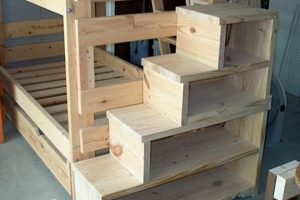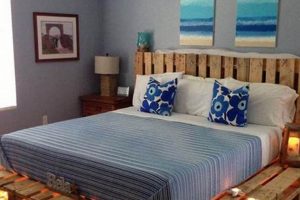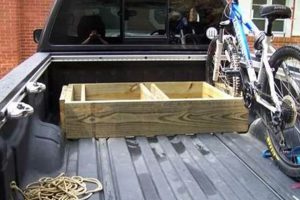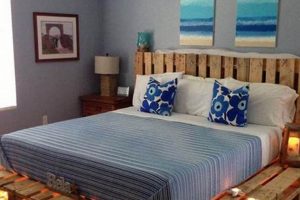The transformation of a sleeping platform into a seating arrangement through do-it-yourself methods involves repurposing existing bed components into the structural framework of a sofa. This process frequently includes modifying the bed frame, headboard, and footboard to create the sofa’s back, arms, and base. For example, a twin-sized bed frame could be adapted by shortening the side rails and re-orienting the headboard to form the backrest of a small couch.
Undertaking such a project presents several advantages, including cost savings, waste reduction through upcycling, and the opportunity for customization. Historically, repurposing furniture has been a common practice during periods of economic hardship or resource scarcity. Furthermore, the result is a unique furnishing that aligns with specific design preferences, contributing to personalized home dcor.
The subsequent discussion will delve into the specific steps involved in this conversion, exploring necessary tools and materials, potential design considerations, and safety precautions to ensure a successful and structurally sound outcome.
Conversion Tips for Bed Frames to Couches
The following guidelines offer direction when undertaking the conversion of a bed frame into a couch, aiming to improve the structural integrity and aesthetic appeal of the finished piece.
Tip 1: Frame Reinforcement. Before modification, assess the bed frame’s structural integrity. Employ metal brackets or wood glue to reinforce joints and corners, ensuring stability under the redistributed weight of a seated individual.
Tip 2: Accurate Measurements. Precisely measure the intended space for the couch and the dimensions of the bed frame. Mark and cut the frame components with consideration for seat depth, back height, and armrest placement.
Tip 3: Secure Fastening. Utilize appropriate fasteners such as lag bolts or screws designed for heavy loads when joining the modified frame sections. Ensure that all fasteners are countersunk to prevent snagging or injury.
Tip 4: Comfortable Seating Support. When integrating seating support, consider using plywood or sturdy wooden slats that distribute weight evenly across the frame. Secure these supports with screws and construction adhesive for added durability.
Tip 5: Aesthetic Considerations. Integrate fabric or upholstery materials that complement the intended decor. Select durable and stain-resistant fabrics suitable for frequent use and potential spills.
Tip 6: Ergonomic Design. Ensure the couch’s dimensions promote comfortable seating posture. Consider back support, armrest height, and seat depth to mitigate potential strain or discomfort during prolonged use.
Tip 7: Safety Inspection. Prior to use, thoroughly inspect the converted couch for sharp edges, loose fasteners, or structural weaknesses. Address any identified hazards to prevent injury.
Adherence to these guidelines will result in a functional and aesthetically pleasing furniture piece, contributing to both resourcefulness and home dcor.
The subsequent sections will discuss common challenges encountered during this conversion process and strategies for effective problem-solving.
1. Frame Modification
Frame modification forms the foundational stage in transforming a bed into a couch through do-it-yourself processes. Its success directly impacts the structural integrity and aesthetic appeal of the finished furniture piece. Improper modifications can compromise stability and usability.
- Dimensional Adjustment
This aspect involves altering the length, width, and height of the bed frame components to suit the intended couch dimensions. For example, a king-size bed frame may need significant reduction to fit a standard living room space. Precise measurements and accurate cutting are crucial to ensure the final couch adheres to planned specifications, preventing misalignment or wasted materials.
- Structural Redesign
Redesign includes re-orienting headboards, footboards, and side rails to function as the couch’s backrest, armrests, and base, respectively. A common adaptation involves repurposing the headboard as a backrest while shortening the side rails to form the couch’s seating area. The success of this process determines the overall structure and stability of the converted unit.
- Joint Reinforcement
Modifying the bed frame necessitates re-establishing and reinforcing the structural joints. Bolting, screwing, and gluing techniques are employed to strengthen the connections between the modified frame components. An example includes using metal brackets to reinforce corners or adding wood glue for increased joint stability. Robust joints are vital for withstanding the stress of regular use.
- Material Compatibility
Frame modification might require incorporating additional materials, such as plywood or lumber, to create a suitable base for seating. Matching these materials with the existing frame is crucial for cohesion and preventing structural inconsistencies. For example, if the bed frame is made of hardwood, using complementary hardwood for the seating platform maintains material integrity and aesthetic consistency.
These facets of frame modification are integral to the transformation process. Successful manipulation ensures structural integrity, aesthetic harmony, and comfortable functionality, demonstrating a well-executed conversion. The careful planning and skilled execution contribute significantly to the durability and visual appeal of the converted furniture.
2. Upholstery Selection
Upholstery selection represents a pivotal determinant in the success of a “bed to couch diy” project, impacting both the aesthetic and functional attributes of the repurposed furniture. The choice of fabric directly influences the overall appearance, dictating whether the converted piece blends seamlessly into the existing decor or stands out as a unique accent. Beyond aesthetics, the material’s durability, stain resistance, and texture affect its longevity and user experience. For instance, a tightly woven, dark-colored fabric like denim or canvas can withstand frequent use and conceal minor blemishes, making it suitable for households with children or pets. Conversely, a delicate, light-colored fabric may offer an elevated aesthetic but prove impractical for high-traffic areas due to its susceptibility to stains and wear.
The practical application of understanding the interplay between upholstery and the “bed to couch diy” method lies in the ability to tailor the conversion to specific needs and lifestyle. The material must accommodate the structural modifications performed on the bed frame. A thicker, more rigid fabric might be necessary to provide additional support to the converted back or arms. The complexity of the upholstery process also affects the selection, from basic slipcovers to more involved, tailored designs. Selecting the appropriate tools and techniques and fabric can simplify the process. Ultimately, the choice should reflect a balance between visual appeal and practical considerations, ensuring that the converted couch is not only attractive but also durable and comfortable for long-term use.
Careful deliberation during the upholstery selection phase mitigates potential issues related to material degradation, structural integrity, and aesthetic incongruity. While the conversion offers an economical and environmentally conscious alternative to purchasing new furniture, neglecting the importance of appropriate upholstery can lead to premature deterioration and negate the initial benefits. Therefore, a thorough assessment of material properties, intended usage, and skill level is essential for achieving a satisfactory and enduring outcome, underscoring the fundamental role of upholstery selection in the “bed to couch diy” endeavor.
3. Structural Reinforcement
Structural reinforcement constitutes a non-negotiable aspect of any bed-to-couch conversion executed through do-it-yourself methods. The integrity of the original bed frame, often designed to support a horizontal load, may be insufficient to withstand the stresses of vertical seating and leaning. Without adequate reinforcement, the resulting couch is prone to instability, failure, and potential injury.
- Joint Stabilization
Existing bed frame joints are typically not engineered for the stresses imposed by a couch configuration. Reinforcement involves adding metal brackets, corner braces, and supplemental fasteners to fortify these connections. A common example is the application of L-brackets at frame corners, distributing the weight more evenly and preventing shearing forces that could lead to joint separation. The implementation of joint stabilization directly correlates with the overall longevity and safety of the converted couch.
- Load Distribution Augmentation
The concentrated weight of seated individuals necessitates the addition of internal supports to distribute the load across the entire frame. This can be achieved through the installation of crossbeams, stringers, or a plywood base. The strategic placement of these supports prevents localized stress concentrations that could cause bowing, cracking, or complete collapse of the frame. For example, installing a plywood sheet beneath the cushions distributes weight across the entire seating area, preventing sagging and increasing structural resilience.
- Material Enhancement
In cases where the original bed frame is constructed from relatively weak materials, supplementation with sturdier components is essential. This may involve adding hardwood supports to reinforce softwood frames or replacing weakened sections with more robust materials. The incorporation of high-strength materials directly addresses the inherent limitations of the original bed frame, ensuring that the converted couch can withstand regular use without compromising structural integrity. The choice of appropriate materials ensures a longer lifespan.
- Fastener Optimization
Standard bed frame fasteners may not be adequate for the redistributed loads of a couch configuration. Upgrading to heavier-gauge screws, bolts, and lag screws is critical for secure assembly. The use of construction adhesive in conjunction with mechanical fasteners provides an additional layer of security, bonding the frame components together and preventing loosening over time. The selection of appropriate fasteners optimizes the overall stability of the converted couch, minimizing the risk of structural failure.
The described facets of structural reinforcement are integral to the successful and safe implementation of any bed-to-couch conversion project. The failure to address these considerations can result in a structurally unsound piece of furniture, posing a significant safety hazard. The application of appropriate reinforcement techniques directly translates to the durability, stability, and long-term usability of the converted couch.
4. Comfort Optimization
Comfort optimization, in the context of bed-to-couch conversions, directly influences the usability and perceived value of the repurposed furniture. The initial purpose of a bed prioritizes sleeping, while a couch serves seating and relaxation. Disregarding ergonomic considerations during conversion results in an aesthetically modified bed frame that remains uncomfortable and therefore underutilized. A thin mattress, adequate for occasional sleep, is insufficient for sustained seating. The resulting discomfort discourages use, negating the intended benefits of a DIY project focused on repurposing and cost savings. A practical example involves replacing a standard bed mattress with high-density foam cushions tailored to seating dimensions. These cushions, coupled with strategically placed lumbar support, significantly improve seating comfort. This adjustment transforms the repurposed furniture from a mere novelty into a functional and enjoyable seating option.
Furthermore, comfort optimization extends beyond cushion selection to encompass frame design and upholstery choices. A poorly angled backrest or inadequately padded armrests compromise comfort regardless of cushion quality. Modifying the frame to provide an ergonomic back angle, typically between 100 and 110 degrees, addresses this issue. Similarly, incorporating padded armrests of an appropriate height and width enhances the overall seating experience. Upholstery also plays a crucial role, contributing to the tactile feel and breathability of the seating surface. A coarse or non-breathable fabric detracts from comfort, regardless of the underlying cushion quality. Selecting soft, durable fabrics that allow air circulation mitigates discomfort during extended use. The holistic combination of these elements significantly impacts user satisfaction.
In conclusion, comfort optimization is not merely an ancillary consideration but an essential component of successful bed-to-couch conversions. Prioritizing ergonomic design, cushion selection, and upholstery choices is paramount in creating a functional and enjoyable seating solution. The neglect of these factors leads to compromised usability and ultimately diminishes the value of the entire undertaking. Overcoming these challenges involves a comprehensive approach that integrates design principles with material selection, ensuring a comfortable and aesthetically pleasing final product.
5. Space Constraints
Space constraints serve as a primary determinant in the feasibility and design of any “bed to couch diy” endeavor. The available area dictates the maximum dimensions of the converted furniture piece, influencing the degree to which the original bed frame can be repurposed. Limited space necessitates careful consideration of scalability and proportion, often requiring significant alterations to the frame. For instance, converting a queen-sized bed frame into a couch for a small apartment may require substantial shortening of the side rails and elimination of armrests to maintain maneuverability within the confined space. Neglecting spatial limitations during the planning phase results in a cumbersome, ill-fitting piece of furniture that compromises functionality and aesthetics.
The impact of spatial restrictions extends beyond dimensional considerations to influence the selection of design elements and features. In tight quarters, multifunctional designs that incorporate storage compartments or convertible elements are particularly advantageous. A “bed to couch diy” project might integrate drawers beneath the seating area or a fold-down backrest that transforms the couch into a temporary guest bed, maximizing utility within a limited footprint. Furthermore, the choice of upholstery and color palettes can contribute to the perception of spaciousness. Lighter hues and streamlined designs create a sense of openness, while bulky forms and dark colors tend to visually compress the area. These design choices must harmonize with the existing environment.
Addressing space constraints in “bed to couch diy” projects requires a thorough assessment of the intended location, precise measurements, and meticulous planning. The successful integration of a repurposed furniture piece into a restricted space hinges on the ability to balance functionality, aesthetics, and spatial efficiency. Failure to adequately address spatial challenges can lead to a dysfunctional and visually jarring outcome. An awareness of the existing space allows the creation of furniture that maximizes utility and complements the surrounding environment.
6. Cost Effectiveness
The impetus behind undertaking a bed-to-couch conversion often stems from a desire for cost reduction. Acquiring new furniture represents a significant expenditure, particularly when factoring in delivery charges and potential assembly costs. By repurposing an existing bed frame, individuals can substantially decrease expenses associated with furnishing a living space. The primary cost drivers in such a project involve consumable materials such as fabric, foam, fasteners, and adhesives, which typically represent a fraction of the cost of a comparable, commercially manufactured couch. For example, an individual possessing basic woodworking skills and access to a discarded bed frame could potentially create a functional couch for under $100, whereas a similar new couch might retail for several hundred dollars or more.
However, a focus on cost effectiveness should not compromise the structural integrity or aesthetic appeal of the converted couch. Premature failure due to inadequate reinforcement or the use of substandard materials negates any initial savings, potentially necessitating replacement with commercially produced furniture. Similarly, a poorly executed upholstery job detracts from the overall aesthetic, diminishing the perceived value of the finished product. To maximize cost effectiveness, it is prudent to prioritize the procurement of durable, high-quality materials at discounted prices, exploring options such as closeout sales or surplus outlets. Employing efficient construction techniques and minimizing material waste further contributes to cost containment. A calculated approach to material acquisition is paramount.
In summary, cost effectiveness constitutes a compelling rationale for engaging in bed-to-couch conversions. However, realizing tangible savings requires a strategic balance between frugality and quality. Investing in durable materials and employing sound construction practices ensures a structurally sound and aesthetically pleasing outcome, maximizing the long-term value of the repurposed furniture. Overly prioritizing cost reduction at the expense of quality compromises the integrity of the finished piece.
7. Design Integration
Design integration, in the context of repurposing a bed frame into a couch, represents the seamless incorporation of the newly transformed furniture piece within the existing aesthetic and functional parameters of a given living space. The success of a bed to couch DIY project hinges not only on structural modifications and upholstery but also on how well the final product complements the rooms existing style, color scheme, and overall functionality. Failure to consider design integration results in a piece of furniture that, regardless of its structural soundness, appears visually incongruous and disrupts the harmonious flow of the room. For example, a rustic, unfinished bed frame converted into a couch may clash dramatically with a modern, minimalist living room, rendering the DIY effort aesthetically unsuccessful. The design integration aims at eliminating this conflict.
Practical application of design integration involves a careful analysis of the room’s existing design elements before commencing the conversion process. This includes noting the predominant colors, textures, and styles of existing furniture, wall treatments, and accessories. The subsequent selection of upholstery fabric, finishes, and embellishments should directly correspond to these established design cues. For instance, if the room features a neutral color palette and clean lines, a couch upholstered in a similar fabric with simple, understated details would promote visual coherence. Conversely, a room with eclectic decor and vibrant colors might accommodate a more adventurous upholstery choice, provided it maintains a cohesive relationship with the room’s overall character. Further, structural design needs consideration; a low-profile couch better integrates into modern spaces.
Ultimately, design integration in bed-to-couch DIY projects elevates the conversion from a mere repurposing exercise to a thoughtfully crafted contribution to the room’s overall aesthetic and functionality. The process demands forethought, careful planning, and a commitment to aligning the newly created furniture piece with the established design language of the space. Challenges may arise in balancing personal design preferences with the existing aesthetic, requiring compromise and careful consideration of visual harmony. The intentional integration of design principles ensures that the converted couch becomes a cohesive and valued element within its surroundings.
Frequently Asked Questions
The following section addresses common inquiries regarding the transformation of a bed into a couch through do-it-yourself methods. These questions aim to clarify potential challenges and provide guidance on best practices.
Question 1: What is the minimum skill level required for a successful bed-to-couch conversion?
A moderate level of proficiency in woodworking, including accurate measuring, cutting, and fastening techniques, is recommended. Familiarity with basic upholstery methods is also beneficial.
Question 2: What types of bed frames are most suitable for conversion?
Solid wood frames with minimal ornamentation are generally the easiest to modify. Metal frames can be adapted, but require specialized cutting and welding skills.
Question 3: How is structural integrity ensured during the conversion process?
Reinforcing joints with metal brackets, adding internal supports, and utilizing appropriate fasteners are crucial steps in maintaining structural stability.
Question 4: What are the primary safety concerns to consider?
Sharp edges, protruding fasteners, and unstable frame components pose potential hazards. Careful sanding, secure fastening, and thorough inspection are essential safety measures.
Question 5: How does one address potential comfort issues?
Selecting high-density foam cushions, incorporating ergonomic back support, and choosing appropriate upholstery materials contribute to a comfortable seating experience.
Question 6: What are the recommended tools for this type of project?
Essential tools include a measuring tape, saw (circular or hand saw), drill, screwdriver, staple gun, and safety glasses. Additional tools may be required depending on the specific design.
The outlined questions and answers provide a foundational understanding of the bed-to-couch conversion process. Proper planning and execution are crucial for a safe and aesthetically pleasing result.
The subsequent sections will delve into potential troubleshooting strategies for common challenges encountered during the conversion process.
Conclusion
The preceding examination of “bed to couch diy” has elucidated the multifaceted considerations involved in transforming a sleeping platform into a functional seating arrangement. Key aspects such as structural integrity, comfort optimization, space constraints, cost-effectiveness, and design integration are critical for a successful conversion. Neglecting these elements risks the creation of an unsafe or aesthetically displeasing piece of furniture, undermining the intent of the endeavor.
The decision to undertake a bed-to-couch conversion should be informed by a realistic assessment of one’s skills, resources, and the specific constraints of the intended environment. While the potential for cost savings and creative expression is undeniable, the project demands meticulous planning and diligent execution to achieve a durable and aesthetically congruent addition to the living space. A cautious approach, prioritizing safety and functionality, will yield the most favorable and enduring outcome.







